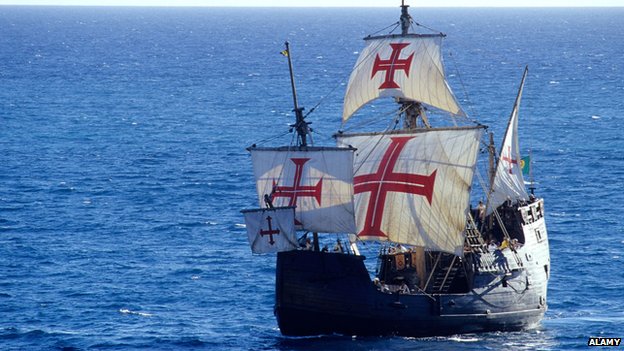Templar Pirates
Records of pirate ships flying flags that signified they were pirates go back just about as far as history is recorded. Of the Jolly Roger line though, the earliest reference is probably of the skull and crossbones flag used by the Knights Templar, who had the world’s biggest naval fleet in the 13th century and were well known for their pirate-like acts on the sea. Interestingly, Templar graves were often marked with the same skull and crossbones as on the Jolly roger (1).
When the Knights Templar dissolved, with many members forming the Knights of Malta who were equally known for their piracy, they also were known to fly the skull and crossbones.
 The most famous Templar Pirate was Roger de Flor (1266-1306). He was also the most famous Templar who was a Templar Sergeant, and not a knight. Roger de Flor (also known by his original German name of Rutger von Blume) was a captain in the Templar fleet (2). After he got banished from the Order on charges of extorting money from passengers during the siege of Acre in 1291, Roger fled to Genoa, where he borrowed a considerable sum from Ticino Doria, purchased a new vessel and began a career in piracy.[1]
The most famous Templar Pirate was Roger de Flor (1266-1306). He was also the most famous Templar who was a Templar Sergeant, and not a knight. Roger de Flor (also known by his original German name of Rutger von Blume) was a captain in the Templar fleet (2). After he got banished from the Order on charges of extorting money from passengers during the siege of Acre in 1291, Roger fled to Genoa, where he borrowed a considerable sum from Ticino Doria, purchased a new vessel and began a career in piracy.[1]
The struggle between the Aragonese kings of Aragon and the French kings of Naples for the possession of Sicily was at this time going on; and Roger by then one of the most experienced military commanders of his time, was called to the service of Frederick, king of Sicily, who gave him the rank of vice-admiral. When the Peace of Caltabellotta brought the war to an end in 1302, Frederick was unwilling and unable to keep a mercenary army and was anxious to free the island from troops (called Almogàvers), whom he had no longer the means of paying. Given the political and military situation, Roger found an opportunity to make his services useful in the east in fighting against the Ottoman Turks, who were ravaging the Byzantine Empire.
Given his position of unchallenged military power, he was accused of serving his own interest instead of those of the emperor because he was determined to found in the East a principality for himself. He sent his treasures to Magnesia, but the people slew his Catalans and seized the treasures. He then laid siege to the town, but his attacks were repulsed, and he was compelled to retire (3). De Flor’s assassination was ordered by the Byzantine Emperor Michael IX Palaeologus.
References
1) http://www.todayifoundout.com/index.php/2011/09/origins-of-the-jolly-roger/
2) A.A. Grishin http://knightstemplarvault.com/famous-knights-templar/
3) https://en.wikipedia.org/wiki/Roger_de_Flor


